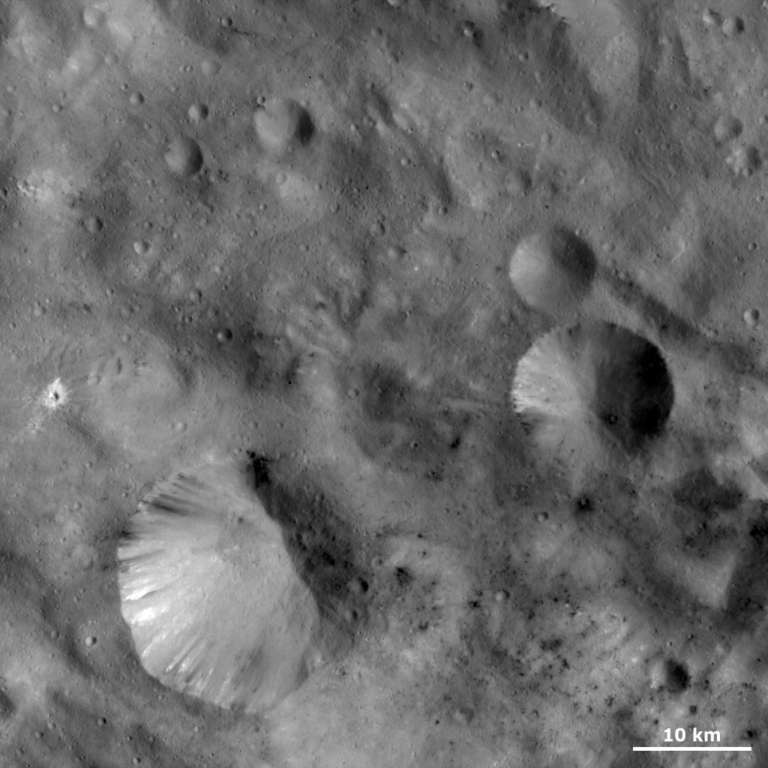All
All
Stories, updates, insights, and original analysis from The Planetary Society.
Chang'E 2 has departed Earth's neighborhood for...asteroid Toutatis!?
According to a Chinese spaceflight forum, Chang'E program chief scientist Ouyang Ziyuan recently announced that Chang'E 2 has departed the Sun-Earth L2 point and is now en route to asteroid 4179 Toutatis!
Steins, a jewel in the asteroid belt
A notice of some new names for features on asteroid 2867 Steins inspired me to dig up the data set from the September 5, 2008 Rosetta flyby and explore it to see what it contained.
More Evidence for Impact Origin for Colombia’s Vichada Structure
Evidence continues to pile up that the Rio Vichada structure in Colombia is indeed the largest impact structure in South America.
Cheat sheets for Vesta's craters and Dawn's Vesta timeline
I made myself a cheat sheet to many of Vesta's distinctive-looking craters, and also wrote down a list of the major dates in the timeline of Dawn's exploration of Vesta.
Pretty Pictures: Amazing Asteroid Lutetia
A long-awaited data set is finally public (well, long-awaited by me, at least). The Rosetta team has now published their data from the July 10, 2010 flyby of asteroid (21) Lutetia. This data set is absolutely stunning, and my friends in the amateur image processing community wasted no time in creating art out of it.
What Saturn's moons can tell us about comets (Notes from LPSC 2012)
My notes on a two-part presentation by collaborators Jim Richardson and David Minton about the sizes of things in the Kuiper belt, a story they told by looking at Saturn's moons. How does that work? What connects Saturn's moons to the Kuiper belt is craters.
La Sagra Observatory discovers very near-Earth asteroid 2012 DA14
With a new CCD camera configured to shoot rapid, short exposures bought with a Planetary Society Shoemaker NEO Grant we caught near-Earth asteroid 2012 DA14.
New "Snapshot From Space": Defending Our Planet
A new installment of our
More Dawn Vesta approach images: First color views
On June 30, Dawn stopped thrusting for a full Vestian day -- five hours and 20 minutes -- and just watched the asteroid rotate. But unlike the previous observations, they used all of Dawn's color filters to acquire the best-ever color photos of the lumpy world.
Where are the big Kuiper belt objects?
Earlier today I wrote a post about how to calculate the position of a body in space from its orbital elements. I'm trying to get a big-picture view of what's going on in trans-Neptunian space.
Dawn images of Vesta! Released!! For everyone!!!
Some time in the last few days, the Dawn team made public the first preliminary version of the first release of their data from the Vesta phase of their mission.
Visiting the San Diego SpaceUp Unconference
Emily Lakdawalla and I drove down to the 3rd annual San Diego SpaceUp Unconference on February 4. We had great fun hanging out with the other space geeks.
Lovely Lovejoy pictures
Just a few of the amazing photos of Comet Lovejoy that have been taken from the southern hemisphere over the last few days. Comet Lovejoy is the first Kreutz sungrazer to have been discovered from the ground in 40 years, and after its surprising survival of its passage close to the Sun, it has been putting on a spectacular show in southern skies.
A recap of Comet Lovejoy
A timeline of one of the most memorable solar events in recent memory: the observations by six Sun-observing spacecraft of Comet Lovejoy making its perihelion passage.
Video: Comet Lovejoy entered SOHO's LASCO C3 field of view this morning!
An animation of comet Lovejoy entering the field of view of one of SOHO's Sun-monitoring cameras.
Notes on Dawn at Vesta from the 2011 American Geophysical Union meeting
A report on the press briefing and talks from the Fall 2011 American Geophyisical Union meeting about the data on Vesta collected so far by Dawn.
Sungrazing with Lovejoy's Comet
Observations of the newly sighted Kreutz sungrazer comet C/2011 W3 (Lovejoy) from the ground and from SOHO (a joint NASA/ESA satellite) and STEREO (NASA's Solar Terrestrial Relations Observatory).
Our friendly neighborhood asteroid, 2005 YU55 (an animation)
Last week JPL released two animations of asteroid 2005 YU55 made from the radar data acquired by Goldstone's 70-meter radio dish.
Goldstone: Desert outpost performs radio imaging of close-passing asteroid 2005 YU55
Anticipating the close flyby of asteroid 2005 YU55 yesterday, the Jet Propulsion Laboratory invited media to tour Goldstone, one of three facilities that make up NASA's Deep Space Network. I've always wanted to see these massive radio dishes up close, so I jumped at the chance!
Live feeds on asteroid 2005 YU55 as it passes Earth
Unless you've been living under a rock you've probably heard that there is a relatively large (400-meter) asteroid passing closer to Earth than the orbit of the Moon today -- in just a few minutes, as a matter of fact.


 Explore Worlds
Explore Worlds Find Life
Find Life Defend Earth
Defend Earth


 Sun
Sun Mercury
Mercury Venus
Venus Earth
Earth Mars
Mars Jupiter
Jupiter Saturn
Saturn Uranus
Uranus Neptune
Neptune Small Bodies
Small Bodies















